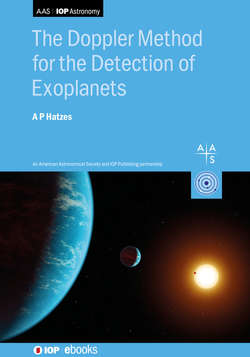Читать книгу The Doppler Method for the Detection of Exoplanets - Professor Artie Hatzes - Страница 47
На сайте Литреса книга снята с продажи.
3.2.2 Spectral Line Strength
ОглавлениеThe RV precision depends on the depth of the stellar line. Clearly, if your line is too weak it will get lost in the noise, and an RV measurement will be next to impossible. Let us define the depth, d, as a value from 0 to 1. A line with d = 1.0 has a depth that is 100% of the continuum, i.e., zero flux in the core of the line. A weak line with d<1.0 will produce a measurement error that is some factor, F, times the measurement error of the stronger line.
Figure 3.8 shows a simulation of the Doppler measurement error as a function of spectral lines of fixed width, but varying depths. This simulation used an S/N = 50, but the results are insensitive to the exact S/N chosen. It shows that 1/F scales linearly with line depth. That is to say, if a line has a depth of one-fifth the continuum, it will have an RV measurement error that is five times greater than that of a line with a depth of 100% of the continuum.
Figure 3.8. The inverse of the multiplicative factor in the RV uncertainty, F, as a function of line strength. (Blue triangles) The factor in the uncertainty for spectral lines of constant width, but a depth that is a fraction of the continuum value (top abscissa). (Red squares) The factor in the RV uncertainty as a function of equivalent width (lower abscissa) for a real spectral line. The best RV precision is for strong, unsaturated lines.
However, real spectral lines do not have a depth that scales linearly with the line strength. Rather, these follow the so-called curve of growth. As one increases the line strength as measured by the equivalent width (EW), the line depth increases, but the width remains fairly constant (Figure 3.9). Once the line starts to saturate, the line depth remains constant, but the wings, and thus the line width, starts to increase. The triangles in Figure 3.8 show how the factor F varies with the EW for real spectral lines. At first, the curve follows the one for lines of fixed width, but after EW≈100 mÅ, the curve starts to flatten out. For the strongest lines, the RV uncertainty actually starts to increase with increasing line strength (Figure 3.8).
Figure 3.9. The change in spectral line shape as a function of increasing line strength.
This behavior can easily be understood in terms of how the RV uncertainty varies with line depth and widths. For weak spectral lines, the increase in EW is due primarily to an increase in the line depth, so the RV uncertainty follows the behavior in our simple simulation (squares in Figure 3.8). Once the line saturates, the line depth increases very slowly, but there is a more rapid increase in the width of the line. It is more difficult to determine the centroid of a broad line as opposed to a narrow line. Whatever gain in precision is achieved by a slightly deeper line is more than offset by the larger line width. In this case, a spectral line with an EW of 100 mÅ yields the same Doppler uncertainty as a line twice as strong. Finally, for the strongest lines, the increase in line width dominates, and the RV uncertainty actually increases with line strength. So, the largest Doppler information is found in strong, yet unsaturated, spectral lines.
